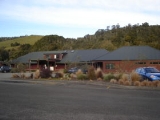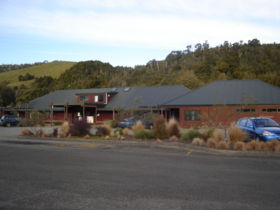
Mt Bruce Wildlife Centre
Encyclopedia
Pukaha Mount Bruce Wildlife Centre is a wildlife restoration organisation based around a protected forest area in New Zealand
's Wairarapa
district.

” which covered the area from Masterton
to Woodville
before European settlement. Most of the bush was destroyed and converted to farmland, but the 942 hectare Mount Bruce block was protected as a Forest Reserve. Some 55 ha of this were further protected as a Native Bird Reserve, administered by the Wildlife Service.
In 1962, the centre was established to breed and release endangered native birds on these 55 hectares. Takahe
(a very rare bird, thought extinct, but rediscovered in Fiordland
) were the first species introduced. In the same decade, a large number of brown teal
s, buff weaks and kakariki
s were released.
A major event occurred in 2001: the entire forest became part of the wildlife reserve, extending the area from 55 to 942 hectares. Therefore, they increased their capacity to breed birds and diversified species, and also started to manage the area. About 100 km of tracks were cut and thousands of traps and bait stations were scattered. Thus they set up an area for the wildlife with a quite low predator pressure.
.
Bird releases started in 1996 with the kākā
, a kind of parrot
. There are currently about 100 in the forest and the goal is to have a population of 600 in a few years. Kiwi
and kokako
followed in 2003. There are only 400 pairs of kokako in New Zealand. Fifteen kiwis are currently living in the forest and five in the centre's nocturnal house, including some chicks. For the breeding programme, they incubate takahe and kiwi eggs to protect chicks and thus give them the chance to become adult.
There are several tourist facilities: a Café, some aviaries to discover the native birds and the nocturnal house where they can see the shy kiwi. Moreover there are some guided visits and a daily feeding demonstrations for kākā and eels.
It is closed only on Christmas Day.
New Zealand
New Zealand is an island country in the south-western Pacific Ocean comprising two main landmasses and numerous smaller islands. The country is situated some east of Australia across the Tasman Sea, and roughly south of the Pacific island nations of New Caledonia, Fiji, and Tonga...
's Wairarapa
Wairarapa
Wairarapa is a geographical region of New Zealand. It occupies the south-eastern corner of the North Island, east of metropolitan Wellington and south-west of the Hawke's Bay region. It is lightly populated, having several rural service towns, with Masterton being the largest...
district.

History
The forest was acquired by the government in the 1870s as part of the “Seventy Mile BushSeventy Mile Bush
The Seventy Mile Bush was a forested area of New Zealand north of Wellington that Scandinavians cut down to clear the land for farming....
” which covered the area from Masterton
Masterton
Masterton is a large town and local government district in the Wellington Region of New Zealand. It is the largest town in the Wairarapa, a region separated from Wellington by the Rimutaka ranges...
to Woodville
Woodville, New Zealand
Woodville is a small town in the southern North Island of New Zealand, 75 km north of Masterton and 25 km east of Palmerston North. In the 2006 census 1,398 people are usually resident in Woodville, a decrease of 81 people, or 5.5%, since the 2001 Census.-Early History and Local...
before European settlement. Most of the bush was destroyed and converted to farmland, but the 942 hectare Mount Bruce block was protected as a Forest Reserve. Some 55 ha of this were further protected as a Native Bird Reserve, administered by the Wildlife Service.
In 1962, the centre was established to breed and release endangered native birds on these 55 hectares. Takahe
Takahe
The Takahē or South Island Takahē, Porphyrio hochstetteri is a flightless bird indigenous to New Zealand and belonging to the rail family. It was thought to be extinct after the last four known specimens were taken in 1898...
(a very rare bird, thought extinct, but rediscovered in Fiordland
Fiordland
Fiordland is a geographic region of New Zealand that is situated on the south-western corner of the South Island, comprising the western-most third of Southland. Most of Fiordland is dominated by the steep sides of the snow-capped Southern Alps, deep lakes and its ocean-flooded, steep western valleys...
) were the first species introduced. In the same decade, a large number of brown teal
Brown Teal
The Brown Teal or New Zealand Teal, is a species of dabbling duck of the genus Anas. The Māori name for it is Pāteke. It was considered to be conspecific with the flightless Auckland and Campbell Teals in Anas aucklandica; the name "Brown Teal" was applied to that entire taxon...
s, buff weaks and kakariki
Kakariki
The three species of Kākāriki or New Zealand parakeets are the most common species of parakeet in the genus Cyanoramphus, family Psittacidae. The birds' Māori name, which is the most commonly used, means "small parrot"....
s were released.
A major event occurred in 2001: the entire forest became part of the wildlife reserve, extending the area from 55 to 942 hectares. Therefore, they increased their capacity to breed birds and diversified species, and also started to manage the area. About 100 km of tracks were cut and thousands of traps and bait stations were scattered. Thus they set up an area for the wildlife with a quite low predator pressure.
Conservation
The main objective of Mount Bruce National Wildlife Centre is to help restore the native wildlife. Currently, the restoration mostly concerns birds, but will expand to bats and reptiles such as the tuataraTuatara
The tuatara is a reptile endemic to New Zealand which, though it resembles most lizards, is actually part of a distinct lineage, order Sphenodontia. The two species of tuatara are the only surviving members of its order, which flourished around 200 million years ago. Their most recent common...
.
Bird releases started in 1996 with the kākā
Kaka
The New Zealand Kaka, also known as Kākā, is a New Zealand parrot endemic to the native forests of New Zealand.-Description:...
, a kind of parrot
Parrot
Parrots, also known as psittacines , are birds of the roughly 372 species in 86 genera that make up the order Psittaciformes, found in most tropical and subtropical regions. The order is subdivided into three families: the Psittacidae , the Cacatuidae and the Strigopidae...
. There are currently about 100 in the forest and the goal is to have a population of 600 in a few years. Kiwi
Kiwi
Kiwi are flightless birds endemic to New Zealand, in the genus Apteryx and family Apterygidae.At around the size of a domestic chicken, kiwi are by far the smallest living ratites and lay the largest egg in relation to their body size of any species of bird in the world...
and kokako
Kokako
The Kōkako is a forest bird which is endemic to New Zealand. It is slate-grey with wattles and a black mask. It is one of three species of New Zealand Wattlebird, the other two being the endangered Tieke and the extinct Huia...
followed in 2003. There are only 400 pairs of kokako in New Zealand. Fifteen kiwis are currently living in the forest and five in the centre's nocturnal house, including some chicks. For the breeding programme, they incubate takahe and kiwi eggs to protect chicks and thus give them the chance to become adult.
Education
Many schools visit the centre. Some sponsor a kiwi, so they can follow its progress since the release. They participate in the LEOTC (Learning experiences Outside the Classroom) education programme, giving them the chance to see the kiwi and to learn about environmental problems facing New Zealand.Tourism
The second biggest mission of the centre is to welcome tourists and to educate them about environmental things and the protection of the wildlife. Indeed, there are about 50,000 visitors per year.There are several tourist facilities: a Café, some aviaries to discover the native birds and the nocturnal house where they can see the shy kiwi. Moreover there are some guided visits and a daily feeding demonstrations for kākā and eels.
Staff
There is a staff of about 15 people. Two work in reception, seven work with the birds or on forest regeneration, two on marketing and communication, three or four at the café. There are also many volunteers, from all over the world, who help the rangers with various tasks including preparing for the bird feeding and maintaining the aviaries and the park for the tourists.It is closed only on Christmas Day.

